Mechanical Properties of MiniBars™ Basalt Fiber-Reinforced Geopolymer Composites
Abstract
:1. Introduction
2. Materials and Methods
2.1. Materials
2.2. Preparation of MiniBars™ FRBC
2.3. Mechanical Characterization of MiniBars™ FRBC
2.4. Scanning Electron Microscopy (SEM) and Optical Microscopy
3. Results and Discussion
4. Conclusions
Author Contributions
Funding
Institutional Review Board Statement
Data Availability Statement
Conflicts of Interest
References
- Ding, Y.; Yu, K.; Li, M. A review on high-strength engineered cementitious composites (HS-ECC): Design, mechanical property and structural application. Structures 2022, 35, 903–921. [Google Scholar] [CrossRef]
- Andrew, R.M. Global CO2 emissions from cement production, 1928–2018. Earth Syst. Sci. Data 2019, 11, 1675–1710. [Google Scholar] [CrossRef]
- Drabczyk, A.; Kudłacik-Kramarczyk, S.; Korniejenko, K.; Figiela, B.; Furtos, G. Review of Geopolymer Nanocomposites: Novel Materials for Sustainable Development. Materials 2023, 16, 3478. [Google Scholar] [CrossRef] [PubMed]
- Korniejenko, K.; Kozub, B.; Bąk, A.; Balamurugan, P.; Uthayakumar, M.; Furtos, G. Tackling the circular economy challenges—Composites recycling: Used tyres, wind turbine blades, and solar panels. J. Compos. Sci. 2021, 5, 243. [Google Scholar] [CrossRef]
- Furtos, G.; Silaghi-Dumitrescu, L.; Pascuta, P.; Sarosi, C.; Korniejenko, K. Mechanical properties of wood fiber reinforced geopolymer composites with sand addition. J. Nat. Fibers 2019, 06, 1–19. [Google Scholar] [CrossRef]
- Furtos, G.; Molnar, L.; Silaghi-Dumitrescu, L.; Pascuta, P.; Korniejenko, K. Mechanical and thermal properties of wood fiber reinforced geopolymer composites. J. Nat. Fibers 2021, 7, 6676–6691. [Google Scholar] [CrossRef]
- Davidovits, J. Chapter 21: Geopolymer fiber-composites. In Geopolymer Chemistry and Applications, 3rd ed.; Institut Géopolymère, Geopolymer Institute: Saint-Quentin, France, 2011; ISBN 9782951482098. [Google Scholar]
- Doğan-Sağlamtimur, N. Waste foundry sand usage for building material production: A first geopolymer record in material reuse. Adv. Civ. Eng. 2018, 2018, 1927135. [Google Scholar] [CrossRef]
- Davidovits, J. Global warming impact on the cement and aggregates industries. World Resour. Rev. 1994, 6, 263–278. [Google Scholar]
- MiniBars™. High Performance Composite Macrofiber for Concrete Reinforcement. Available online: https://reforcetech.com/technology/minibars/ (accessed on 21 November 2023).
- Shafei, B.; Kazemian, M.; Dopko, M.; Najimi, M. State-of-the-art review of capabilities and limitations of polymer and glass fibers used for fiber-reinforced concrete. Materials 2021, 14, 409. [Google Scholar] [CrossRef]
- Ranjbar, N.; Zhang, M. Fiber-reinforced geopolymer composites: A review. Cem. Concr. Compos. 2020, 107, 103498. [Google Scholar] [CrossRef]
- Sathanandam, T.; Awoyera, P.O.; Vijayan, V.; Sathishkumar, K. Low carbon building: Experimental insight on the use of fly ash and glass fibre for making geopolymer concrete. Sustain. Environ. Res. 2017, 27, 146–153. [Google Scholar] [CrossRef]
- Wang, T.; Fan, X.; Gao, C.; Qu, C.; Liu, J.; Yu, G. The influence of fiber on the mechanical properties of geopolymer concrete: A review. Polymers 2023, 15, 827. [Google Scholar] [CrossRef] [PubMed]
- Uzun, I. Methods of determining the degree of crystallinity of polymers with X-ray diffraction: A review. J. Polym. Res. 2023, 30, 394. [Google Scholar] [CrossRef]
- DURAMUL. Available online: https://www.washingtonmills.com/products/fused-mullite/duramul (accessed on 21 November 2023).
- Fernández-Jiménez, A.; Palomo, A.; Criado, M. Microstructure development of alkali-activated fly ash cement: A descriptive model. Cem. Concr. Res. 2005, 35, 1204–1209. [Google Scholar] [CrossRef]
- Luna-Galiano, Y.; Leiva, C.; Arenas, C.; Fernández-Pereira, C. Fly ash based geopolymeric foams using silica fume as pore generation agent. Physical, mechanical and acoustic properties. J. Non-Cryst. Solids 2018, 500, 196–204. [Google Scholar] [CrossRef]
- Baldea, B.; Silaghi-Dumitrescu, L.; Furtos, G. Fracture load and force load at upper yield of alkaline-resistant glass fiber-reinforced endodontic posts. Polym. Compos. 2017, 38, 260–267. [Google Scholar] [CrossRef]
- Furtos, G.; Silaghi-Dumitrescu, L.; Moldovan, M.; Baldea, B.; Trusca, R.; Prejmerean, C. Influence of filler/reinforcing agent and post-curing on the flexural properties of woven and unidirectional glass fiber reinforced composites. J. Mater. Sci. 2012, 47, 3305–3314. [Google Scholar] [CrossRef]
- Furtos, G.; Tomoaia-Cotisel, M.; Baldea, B.; Prejmerean, C. Development and characterization of new AR glass fiber reinforced cements with potential medical applications. J. Appl. Polym. Sci. 2013, 128, 1266–1273. [Google Scholar] [CrossRef]
- Muhammad, J.H.; Yousif, A.R. Effect of basalt minibars on the shear strength of BFRP-reinforced high-strength concrete beams. Case Stud. Constr. Mater. 2023, 18, e02020. [Google Scholar] [CrossRef]
- Vishu, S. Handbook of Plastic Testing Technology, 2nd ed.; John Wiley: New York, NY, USA, 1998; p. 546. [Google Scholar]
- DeBoer, J.; Vermilyea, S.G.; Brady, R.E. The effect of carbon fiber orientation on the fatigue resistance and bending properties of two denture resins. J. Prosthet. Dent. 1984, 51, 119. [Google Scholar] [CrossRef]
- Wang, X.; He, J.; Mosallam, A.S.; Li, C.; Xin, H. The Effects of Fiber Length and Volume on Material Properties and Crack Resistance of Basalt Fiber Reinforced Concrete (BFRC). Adv. Mater. Sci. Eng. 2019, 2019, 7520549. [Google Scholar] [CrossRef]
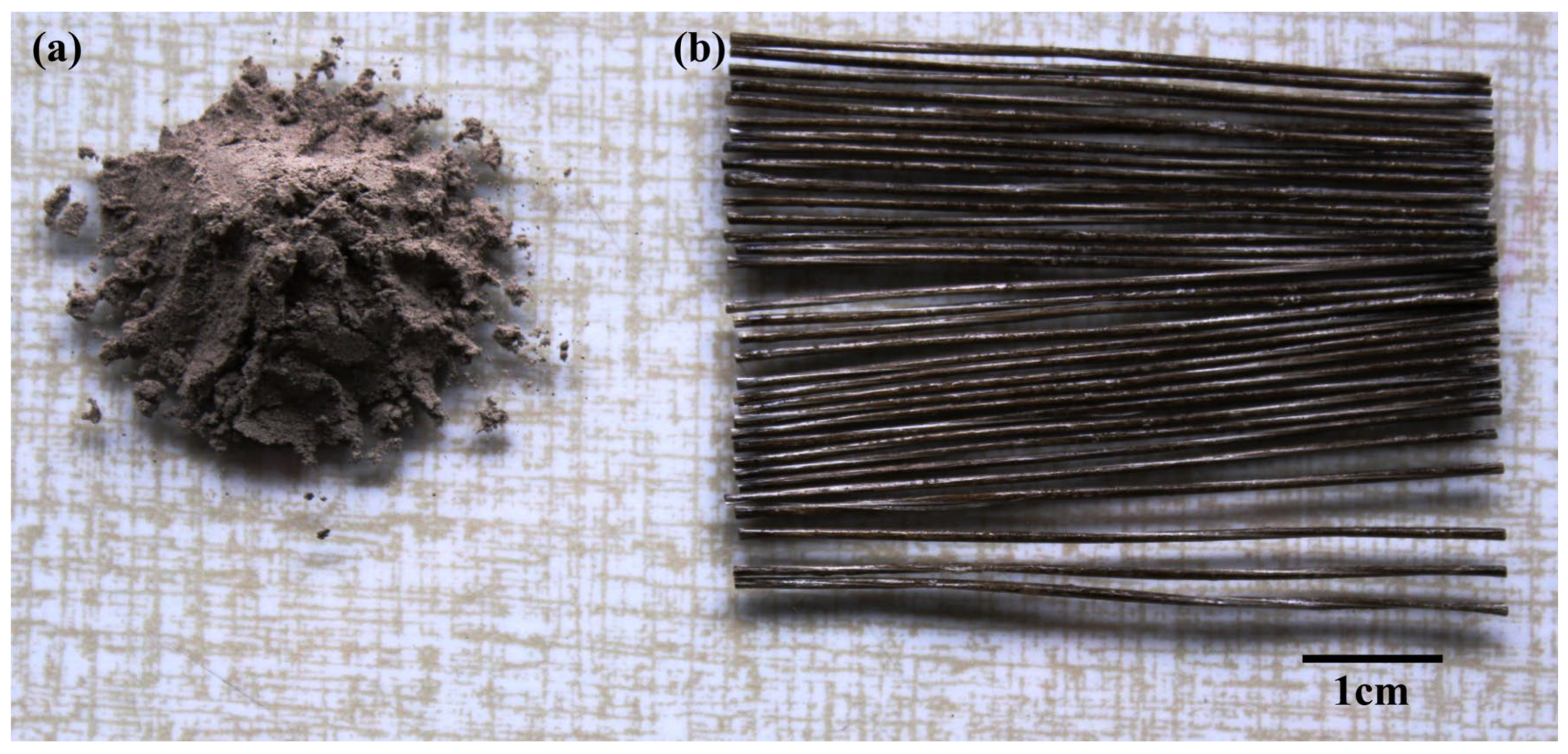
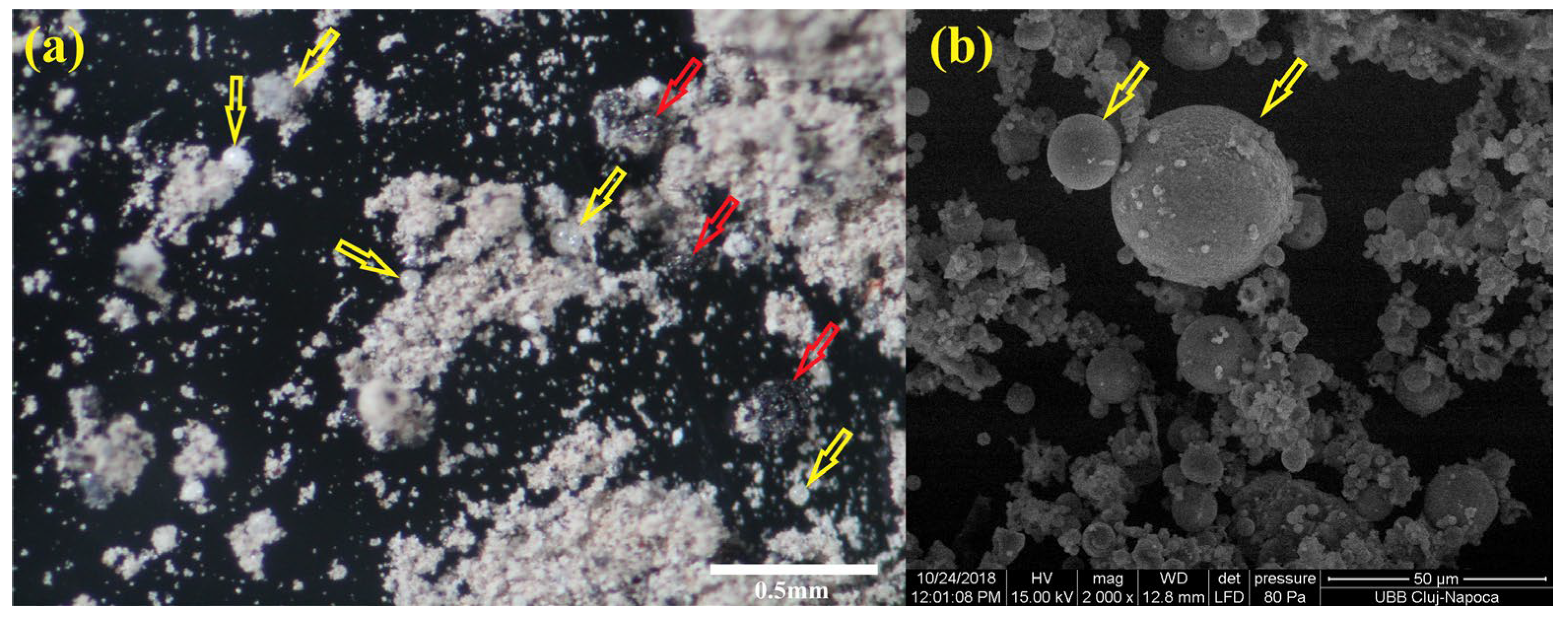

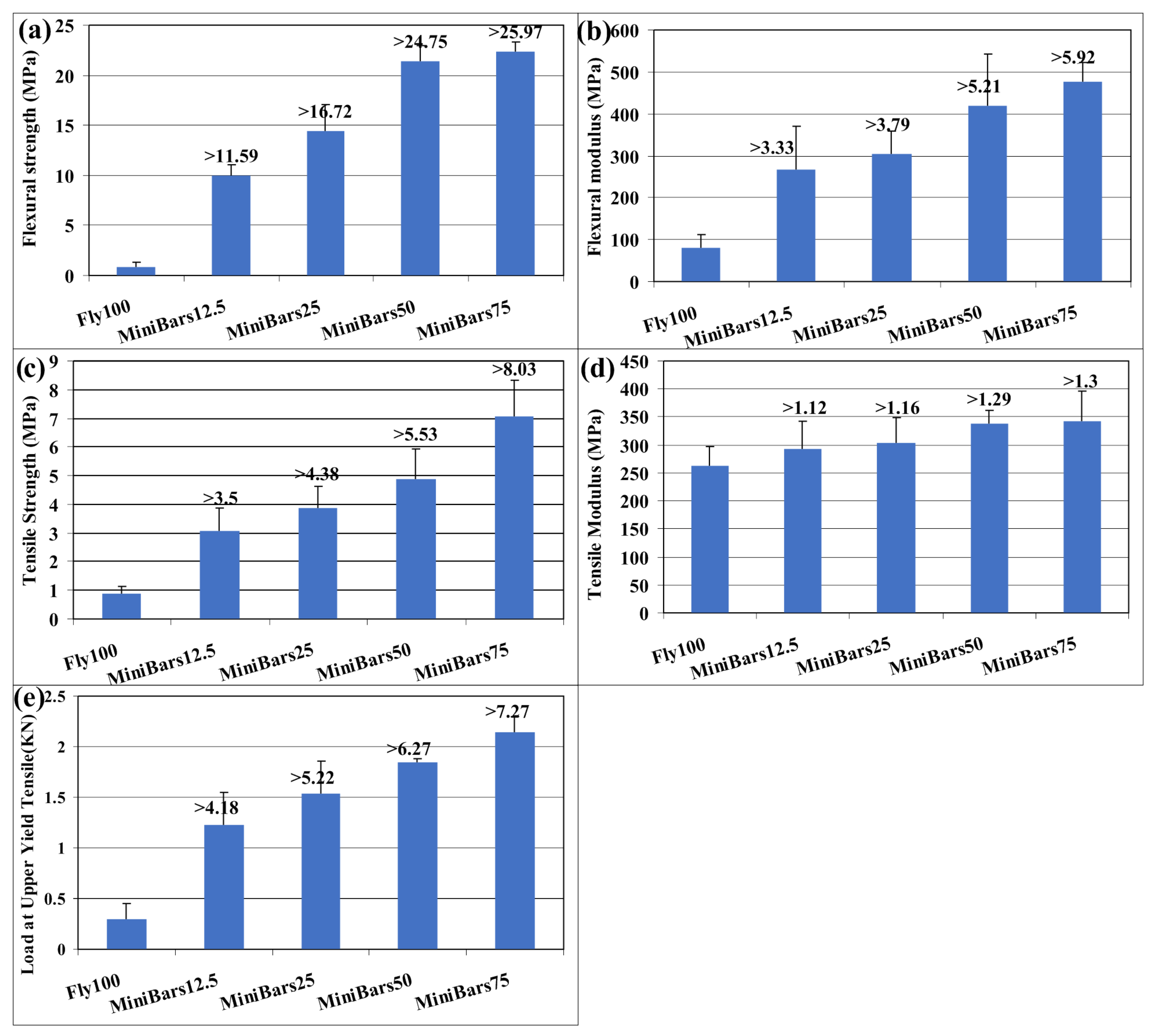
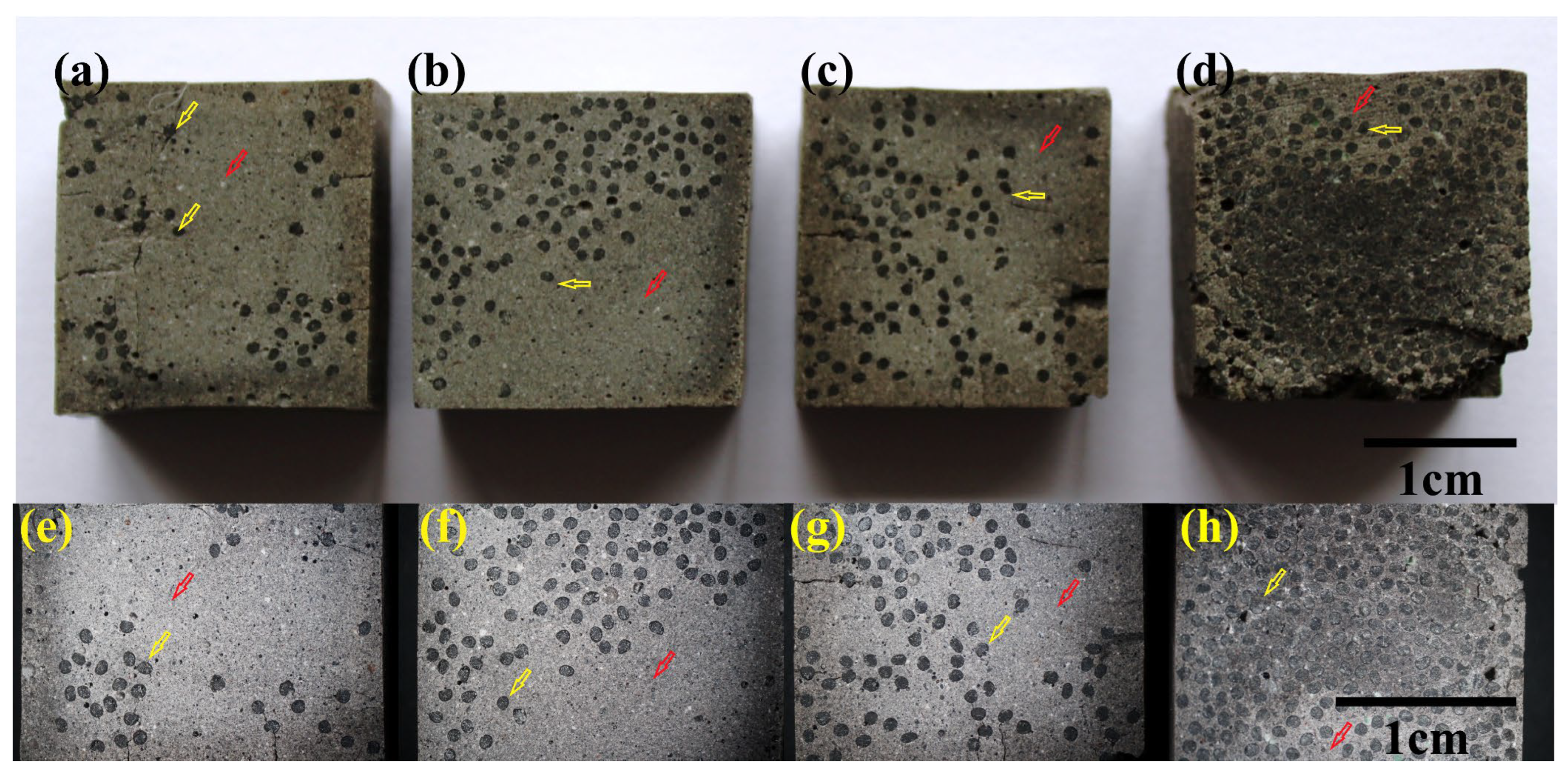
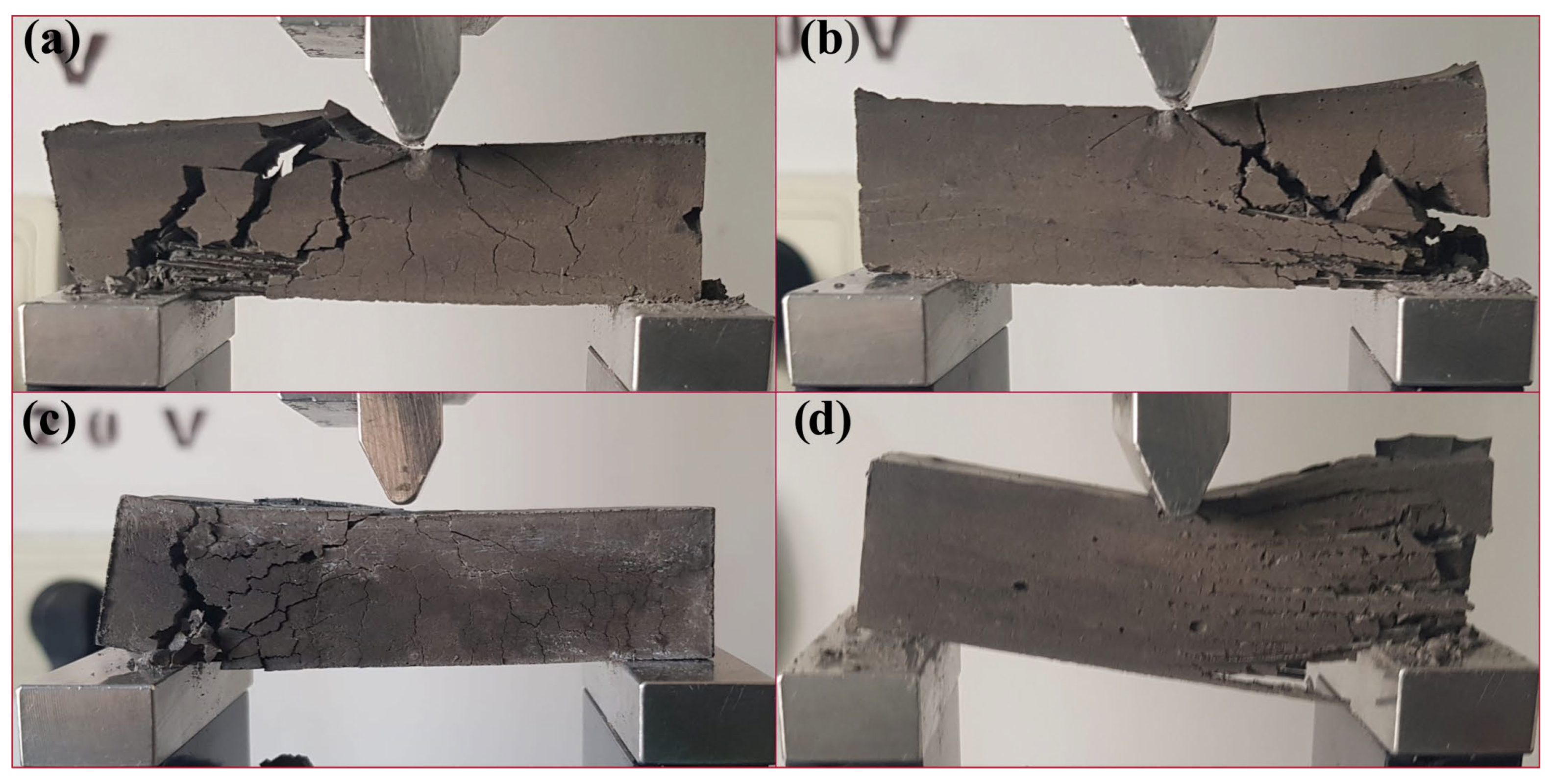

| Nr. | Code | vol. % MiniBars | wt. % MiniBars |
|---|---|---|---|
| 1 | Fly100 | 0 | 0 |
| 2 | MiniBars12.5 | 12.5 | 2.44 |
| 3 | MiniBars25 | 25 | 4.88 |
| 4 | MiniBars50 | 50 | 9.75 |
| 5 | MiniBars75 | 75 | 14.63 |
Disclaimer/Publisher’s Note: The statements, opinions and data contained in all publications are solely those of the individual author(s) and contributor(s) and not of MDPI and/or the editor(s). MDPI and/or the editor(s) disclaim responsibility for any injury to people or property resulting from any ideas, methods, instructions or products referred to in the content. |
© 2024 by the authors. Licensee MDPI, Basel, Switzerland. This article is an open access article distributed under the terms and conditions of the Creative Commons Attribution (CC BY) license (https://creativecommons.org/licenses/by/4.0/).
Share and Cite
Furtos, G.; Prodan, D.; Sarosi, C.; Moldovan, M.; Korniejenko, K.; Miller, L.; Fiala, L.; Iveta, N. Mechanical Properties of MiniBars™ Basalt Fiber-Reinforced Geopolymer Composites. Materials 2024, 17, 248. https://doi.org/10.3390/ma17010248
Furtos G, Prodan D, Sarosi C, Moldovan M, Korniejenko K, Miller L, Fiala L, Iveta N. Mechanical Properties of MiniBars™ Basalt Fiber-Reinforced Geopolymer Composites. Materials. 2024; 17(1):248. https://doi.org/10.3390/ma17010248
Chicago/Turabian StyleFurtos, Gabriel, Doina Prodan, Codruta Sarosi, Marioara Moldovan, Kinga Korniejenko, Leonard Miller, Lukáš Fiala, and Nováková Iveta. 2024. "Mechanical Properties of MiniBars™ Basalt Fiber-Reinforced Geopolymer Composites" Materials 17, no. 1: 248. https://doi.org/10.3390/ma17010248










